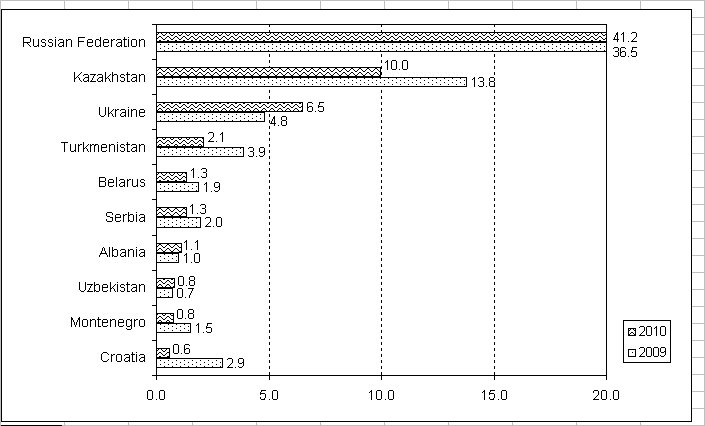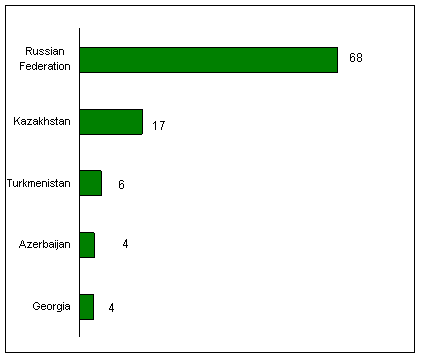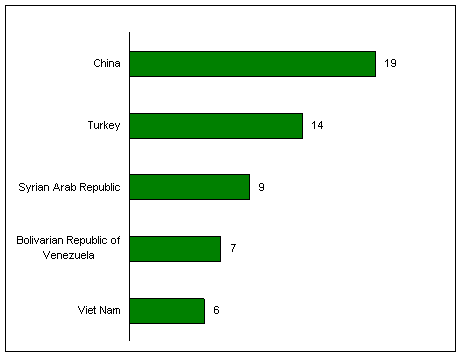| EMBARGO The contents of this press release and the related Report must not be quoted or summarized in the print, broadcast or electronic media before 26 July 2011,17:00 [GMT] (13:00 New York; 19:00 Geneva, 22:30 New Delhi, 02:00 - 27 July Tokyo) |
Geneva, 26 July 2011 - Foreign direct investment (FDI) flows to the transition economies of South-East Europe declined sharply in 2010, UNCTAD´s annual survey of investment trends reports. Those to the Commonwealth of Independent States (CIS)(1) rose modestly.
The World Investment Report 2011(2), subtitled "Non-equity modes of international production and development", was released today.
The publication reveals that FDI inflows to the CIS countries rose only marginally. FDI to the region´s largest economy, the Russian Federation (figure 1), rose 13 per cent to $41 billion. Foreign investors continue to be attracted to the fast-growing local consumer market. The acquisition of the Russian soft drinks brand Wimm-Bill-Dann by PepsiCo for $3.8 billion was seen as a sign of investor confidence in the country. FDI flows to Ukraine increased by 35 per cent (figure 1) due to better macroeconomic conditions. FDI inflows declined in Kazakhstan in 2010, although it remained the second-largest recipient in the subregion. These three countries continued to occupy the top three positions as recipients in 2010 (figure 1).
In contrast to CIS, FDI flows to South-East Europe fell for the third consecutive year. The decline in 2010 came to 47 per cent, partly as a result of sluggishness in investment from EU countries, traditionally the dominant source of FDI in this subregion. The decline of FDI is also structural: investors rarely set up export-oriented projects in the subregion, which has been excluded from international production networks of transnational corporations (TNCs) - the engine of recovery in 2010. FDI flows to Croatia and Serbia declined sharply in 2010, while Albania saw its FDI inflows rise to more than $1 billion for the first time, making it the second-largest FDI recipient in the subregion after Serbia (figure 1).
Outward FDI flows, mainly driven by Russian TNCs, rose by 24 per cent in 2010, thanks to better cash flows of TNCs located in the region, higher commodity prices, economic recovery and strong support by the state.
Investment links between developing and transition economies are gaining momentum, the report says. TNCs based in transition economies and developing economies have increasingly ventured into each other´s markets. The share of developing countries in greenfield investment projects from transition economies rose to 60 per cent in 2010 (up from only 30 per cent in 2004). This translated into an increase of $7.3 billion, from $4.4 billion to $11.7 billion. Similarly, the developing-country share in transition economies´ greenfield investment projects rose from 9 per cent in 2004 to 21 per cent in 2010, or from $6 billion to $11 billion. South-East investment links are concentrated in a handful of key countries: Kazakhstan and the Russian Federation are the main targets of developing-country investors, whereas China and Turkey are the most popular destinations for FDI from transition economies (figure 2). At the same time, Central Asian countries have been increasingly targeted by neighbouring Chinese TNCs, and Africa has attracted important investment flows from the Russian Federation.
South-East interregional FDI has benefited from outward FDI support from their governments through, for example, regional cooperations, such as that of the Shanghai Cooperation Organisation, and bilateral partnerships.
Prospects for inward FDI to transition economies are positive, the report says. FDI inflows are expected to increase in 2011 because of a more investor-friendly environment, the expected accession of the Russian Federation to the World Trade Organization and a new round of privatizations in the major host countries of the region (Russian Federation and Ukraine). Outward FDI is expected to pick up in 2011-2013 due to stronger commodity prices and economic recovery in countries with large natural resources. In the first five months of 2011, the cross-border merger and acquisitions purchases in the region increased by more than 7 times over the same period in 2010.
The World Investment Report and its database are available online at http://www.unctad.org/wir and http://www.unctad.org/fdistatistics and http://www.unctad.org/diae |
Overview in French
Overview in Spanish
Overview in Arabic
Overview in Russian
Overview in Chinese
ANNEX
Tables and figures
Figure 1. Transition economies: top 10 recipients of FDI inflows, 2009, 2010(Billions of dollars)
Source: UNCTAD, World Investment Report 2011.
Note:Countries ranked on the basis of the magnitude of 2010 FDI inflows.
Figure 2. Top 5 destinations of FDI projects, cumulative 2003 2010(Billions of dollars)
a) From developing to transition economies
Total FDI project value = $109 billion

b) From transition to developing economies
Total FDI project value = $99 billion

Source: UNCTAD, World Investment Report 2011.


